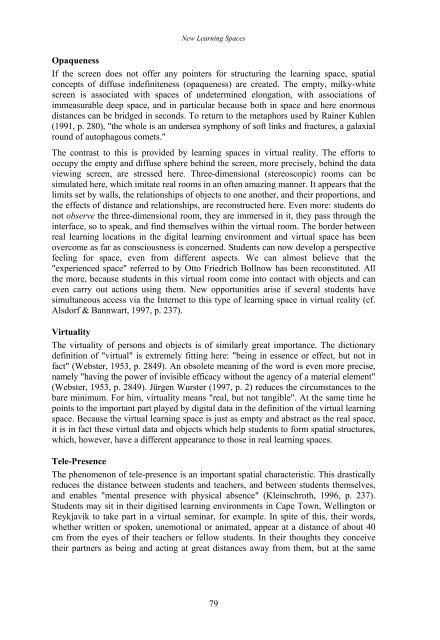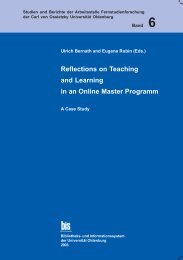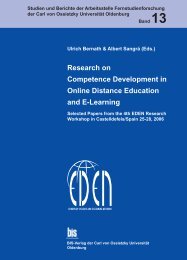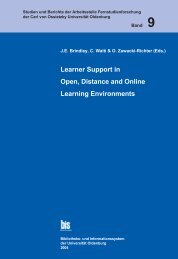Distance Education in Transition - Master of Distance Education ...
Distance Education in Transition - Master of Distance Education ...
Distance Education in Transition - Master of Distance Education ...
You also want an ePaper? Increase the reach of your titles
YUMPU automatically turns print PDFs into web optimized ePapers that Google loves.
New Learn<strong>in</strong>g Spaces<br />
Opaqueness<br />
If the screen does not <strong>of</strong>fer any po<strong>in</strong>ters for structur<strong>in</strong>g the learn<strong>in</strong>g space, spatial<br />
concepts <strong>of</strong> diffuse <strong>in</strong>def<strong>in</strong>iteness (opaqueness) are created. The empty, milky-white<br />
screen is associated with spaces <strong>of</strong> undeterm<strong>in</strong>ed elongation, with associations <strong>of</strong><br />
immeasurable deep space, and <strong>in</strong> particular because both <strong>in</strong> space and here enormous<br />
distances can be bridged <strong>in</strong> seconds. To return to the metaphors used by Ra<strong>in</strong>er Kuhlen<br />
(1991, p. 280), "the whole is an undersea symphony <strong>of</strong> s<strong>of</strong>t l<strong>in</strong>ks and fractures, a galaxial<br />
round <strong>of</strong> autophagous comets."<br />
The contrast to this is provided by learn<strong>in</strong>g spaces <strong>in</strong> virtual reality. The efforts to<br />
occupy the empty and diffuse sphere beh<strong>in</strong>d the screen, more precisely, beh<strong>in</strong>d the data<br />
view<strong>in</strong>g screen, are stressed here. Three-dimensional (stereoscopic) rooms can be<br />
simulated here, which imitate real rooms <strong>in</strong> an <strong>of</strong>ten amaz<strong>in</strong>g manner. It appears that the<br />
limits set by walls, the relationships <strong>of</strong> objects to one another, and their proportions, and<br />
the effects <strong>of</strong> distance and relationships, are reconstructed here. Even more: students do<br />
not observe the three-dimensional room, they are immersed <strong>in</strong> it, they pass through the<br />
<strong>in</strong>terface, so to speak, and f<strong>in</strong>d themselves with<strong>in</strong> the virtual room. The border between<br />
real learn<strong>in</strong>g locations <strong>in</strong> the digital learn<strong>in</strong>g environment and virtual space has been<br />
overcome as far as consciousness is concerned. Students can now develop a perspective<br />
feel<strong>in</strong>g for space, even from different aspects. We can almost believe that the<br />
"experienced space" referred to by Otto Friedrich Bollnow has been reconstituted. All<br />
the more, because students <strong>in</strong> this virtual room come <strong>in</strong>to contact with objects and can<br />
even carry out actions us<strong>in</strong>g them. New opportunities arise if several students have<br />
simultaneous access via the Internet to this type <strong>of</strong> learn<strong>in</strong>g space <strong>in</strong> virtual reality (cf.<br />
Alsdorf & Bannwart, 1997, p. 237).<br />
Virtuality<br />
The virtuality <strong>of</strong> persons and objects is <strong>of</strong> similarly great importance. The dictionary<br />
def<strong>in</strong>ition <strong>of</strong> "virtual" is extremely fitt<strong>in</strong>g here: "be<strong>in</strong>g <strong>in</strong> essence or effect, but not <strong>in</strong><br />
fact" (Webster, 1953, p. 2849). An obsolete mean<strong>in</strong>g <strong>of</strong> the word is even more precise,<br />
namely "hav<strong>in</strong>g the power <strong>of</strong> <strong>in</strong>visible efficacy without the agency <strong>of</strong> a material element"<br />
(Webster, 1953, p. 2849). Jürgen Wurster (1997, p. 2) reduces the circumstances to the<br />
bare m<strong>in</strong>imum. For him, virtuality means "real, but not tangible". At the same time he<br />
po<strong>in</strong>ts to the important part played by digital data <strong>in</strong> the def<strong>in</strong>ition <strong>of</strong> the virtual learn<strong>in</strong>g<br />
space. Because the virtual learn<strong>in</strong>g space is just as empty and abstract as the real space,<br />
it is <strong>in</strong> fact these virtual data and objects which help students to form spatial structures,<br />
which, however, have a different appearance to those <strong>in</strong> real learn<strong>in</strong>g spaces.<br />
Tele-Presence<br />
The phenomenon <strong>of</strong> tele-presence is an important spatial characteristic. This drastically<br />
reduces the distance between students and teachers, and between students themselves,<br />
and enables "mental presence with physical absence" (Kle<strong>in</strong>schroth, 1996, p. 237).<br />
Students may sit <strong>in</strong> their digitised learn<strong>in</strong>g environments <strong>in</strong> Cape Town, Well<strong>in</strong>gton or<br />
Reykjavik to take part <strong>in</strong> a virtual sem<strong>in</strong>ar, for example. In spite <strong>of</strong> this, their words,<br />
whether written or spoken, unemotional or animated, appear at a distance <strong>of</strong> about 40<br />
cm from the eyes <strong>of</strong> their teachers or fellow students. In their thoughts they conceive<br />
their partners as be<strong>in</strong>g and act<strong>in</strong>g at great distances away from them, but at the same<br />
79





